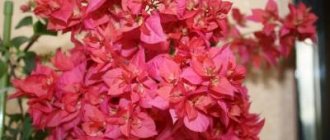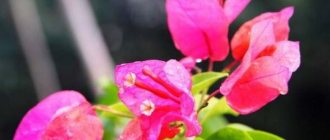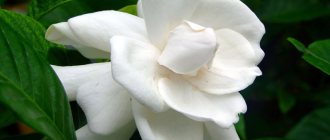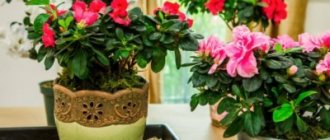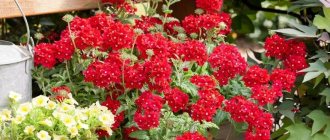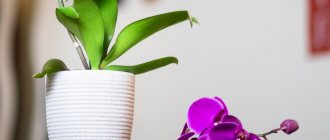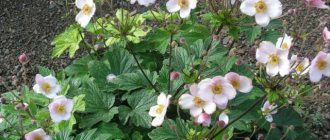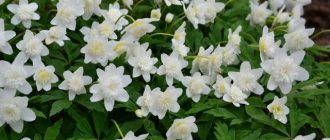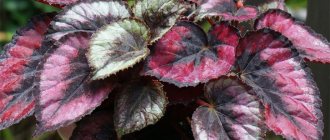Bougainvillea was discovered and described just over 250 years ago. The French botanist Philibert Commerson did this, but they named the plant discovered in the forests of southern Brazil in honor of Count Louis Antoine de Bougainville (1), because it was he who was the leader of the first French circumnavigation of the world, which gave the world many discoveries, including representatives of the flora. And although the name of Bougainville, a traveler, navigator, member of the Paris Academy of Sciences, bears the name of an island, several straits, a cape, a reef, a deep ocean basin and a waterfall, the count himself pinned his hope for fame only on this amazing flower. Well, an aristocrat cannot be denied insight!
In their native Brazil, plants can reach 15 m and live up to 200 years. There they do not have a dormant period and continuously grow and bloom, because the temperature does not drop to a dangerous level below 5 ° C.
In the tropics and subtropics around the world, bougainvillea also feels very comfortable. It was especially loved in Italy, France, and other warm European countries. There, designers create masterpieces of landscape art from plastic, unpretentious climbing bushes and trees with numerous thorns.
The paradox of bougainvillea is that its flowers themselves are inconspicuous! Most often these are small white, yellow or cream stars; they quickly wither and fall off. The bracts (bractea), which differ in color, quantity, and shape - in the form of a heart, oval, arrow, triangle, are valuable. Pearly milky, pink, violet, lilac, purple, yellow-lemon, greenish - they are translucent, like slightly crumpled parchment, which is why they are often called paper. They say that if you create a picture from them, it will not contain only blue and dark blue colors. This is exactly what breeders dream of breeding! So far it hasn’t worked out... Well, bracts with existing shades are successfully used for dyeing linen fabrics.
In indoor conditions, bracts can decorate the plant from six to seven months, from May to November, and sometimes even in winter, if you create comfort for the bougainvillea similar to natural! But most often from November to March-April the plants are dormant.
Bougainvillea species
Despite the fact that the bougainvillea genus includes 18 species, four are used for breeding.
Bougainvillea glabra. It grows no higher than 5 m; its leaves are sometimes not visible behind the bracts. That's why she's naked! Easily amenable to crown formation.
Wonderful bougainvillea (Bougainvillea spectabilis). Tall. The underside of its leaves is velvety, and the bracts are distinguished by a wide palette of colors. In the south it is indispensable for vertical gardening of facades.
Peruvian bougainvillea (Bougainvillea peruviana). It is good not so much in itself as it is important for breeding work. The species bushes little, so it needs to be pruned often. But it blooms for a long time and takes root well.
Bougainvillea × buttiana. A hybrid species that appeared after crossing Bougainvillea glabra and Peruvian. He took all the best from his parents: beauty and long flowering.
Bougainvillea is naked. Photo: YouTube
Bougainvillea is wonderful. Photo: YouTube
Bougainvillea peruviana. Photo: YouTube
Bougainvillea Buttiana. Photo: YouTube
Description of the variety
Externally, the perennial is a large vine with long stems. They grow very quickly and climb well, but become woody with age. The branches are covered with oval leaves with a sharp end, which taper closer to the petiole. The length of the leaf plate does not exceed 15 cm, and it is painted in a rich green color and slightly shines.
A distinctive feature of smooth bougainvillea (the plant also has this name) is the absence of thorns on the shoots, which thickly cover the branches of other varieties.
Bougainvillea glabra is a sister plant to 18 species of bougainvillea in the family Nyctoginaceae, which grow wild in the warm climates of South America. It is sometimes called Paper Flowers because of its thin, papery bracts. Bougainvilleas of different species produce bracts that are pink, purple, violet, red, orange, white or yellow. The plant got its name from the name of the French botanist Bougainville. Bougainvillea glabra (Bougainvillea glabra) is most often grown indoors.
During the flowering period, small yellow inflorescences bloom on the branches on a long tube-like stem. They can be either single or collected in small groups of 2-3 pieces. Around the inflorescences there are large, oval bracts with a pointed tip, 3 cm in diameter.
It is a thorny climbing evergreen shrub that can grow from 1 m to 5 m in natural conditions. Bougainvillea glabra is a beautiful plant that is grown for the colorful bracts that adorn the plant.
Bougainvillea uses a support, but it can grow as a small tree. Therefore, it is used for growing bonsai. The tree trunk has sharp thorns on which dark wax is formed. The leaves are alternate, oval-pointed, 4 cm or more long, with smooth edges. The flowers are small, usually white, surrounded by bright large bracts of crimson color. The fruits are narrow, five-lobed achenes.
The parent variety of bougainvillea glabra has purple bracts. Hybrids bred on its basis can have different colors (white, red, pink, yellow and other shades).
Bougainvillea varieties
Precisely because species were constantly crossed with each other to obtain varieties, it makes sense to classify the latter only according to the main decorative characteristics.
Bougainvillea Diamond. Photo: YouTube
Changing color. Over time, the bracts transform and change color. Among these varieties are:
- Chilean large (Big Chilly) - bracts are large, triangular, narrowed, elongated, first orange-red, then purple, white flowers;
- Brilliant - medium-sized bracts, first bright red, then bright purple;
- Daybreak Pixie is a dwarf with yellow bracts that then turn beige. Flowers peek out from them thanks to long thin “legs”; the leaves are small;
- California Gold - has large, round, sharp-tipped, golden bracts. By the end of flowering, they transform into pale yellow, peach and even almost white;
- Sakura is a compact variety with soft pink bracts that turn pure white with pink veins at the end of the season.
Bougainvillea Rose tree.
Photo: YouTube Terry. Instead of the usual three “paper” petals, they have 6–7 pieces. They can also change shades.
- Rose tree (Bois De Roses) – as the flowers bloom, the color of the bracts changes from orange to pink and purple;
- Klong fire is a densely double variety; in bright sun the bracts glow crimson with pronounced orange flares;
- Thai Gold - bracts change from gold to pink and lilac;
- Aussie Gold is a variety with yellow bracts.
Bougainvillea Chitra.
Photo: YouTube Bicolor. These varieties have bracts of different colors on different branches of the same plant. Or the bracts themselves are painted in two colors (bicolor).
- Chitra, or Hitra ( Chitra ) - large-sized with huge, marbled, white-pink or yellowish-purple bracts;
- Beggar Sikkander ( Beggum Sikkander ) – the bracts are very large, white with a pink border;
- Strawberry Lace - a shrub up to 3 m tall, has both white and bright pink bracts on different branches, many petals are doubly colored ;
- Snow Cap Multi - on one plant the bracts are crimson, white and variegated, at the beginning of flowering the red color is combined with yellow, at the end it acquires crimson-white shades .
Bougainvillea Mary Palmer.
Photo: YouTube Variegated. Another name is variegated. Due to the uneven distribution of chlorophyll and other pigments, each leaf turns out to be variegated - white-green, for example.
- Mary Palmer - bicolor in rich pink and snowy white tones;
- San Diego Red Variegato - striking with golden - green leaves and red perianths with bright white flowers in them;
- Delta Dawn - orange and brown bracts;
- Sunset Pixie Variegated - green leaves and pink bracts.
Popular types and varieties
Photo: https://pixabay.com/photos/triple-flower-bougainvillea-mallorca-4292690/
Bougainvillea glabra
A tall bush, reaching five meters, almost completely covered with bright flowers, behind which no leaves are visible. Prefers dry climate and rocky soils. The leaves are dark green, glossy. There are small thorns on the shoots.
Blooms in white, yellow, red, purple and pink. It grows well and tolerates pruning well, so the shrub can be given any shape.
Bougainvillea beautiful or wonderful (Bougainvillea spectabilis)
This is a vine with large red, pink or purple flowers. One shoot can grow up to fifteen meters in length. Thanks to its numerous thorns, the vine entwines even the even and almost smooth walls of houses.
The leaves are heart-shaped, dense, with a pubescent covering. The flowers are collected in panicle inflorescences, the peak of flowering occurs in April-October.
Peruvian bougainvillea (Bougainvillea peruviana)
It is a strongly climbing shrub. The flowers are yellow, and the large double bracts are pink, purple or lilac. The leaves are thin, smooth, without edges, ovoid in shape with a pointed tip. The shoots are long and do not produce lateral shoots. To make the plant look lush, it must be pruned. Flowering occurs several times a year.
Based on these three species, breeders have developed many varieties and hybrids. True, they were never able to get a flower with blue bracts and completely rid the plant of thorns.
The most popular varieties and hybrids
- Australian Gold. A shrub with large oval leaves of light green color, on which burgundy spots periodically appear. The bracts are double, at the beginning of flowering they are bright orange in color, and then lighten and turn pink.
- Double Lilarose. Very “fluffy”, double pink flowers.
- Beggum Sikkander. Lush two-color flowers - white background with purple edging.
- White Cascade. A delicate plant due to its ivory colored bracts and dark green leaves. Sometimes a pink edging appears on the “petals”.
- Double Red. A double variety with bright crimson bracts, which remain invariably rich throughout their flowering period.
- California Gold. At the beginning of flowering it has a bright golden color, which eventually turns into beige. A distinctive feature is that it periodically “gets confused” in the seasons and can bloom in winter.
- Jamaica White. The bracts are snow-white, and the flowering is very abundant and long-lasting.
- Tomato Red. Bright flowers of “tomato” color.
- Mary Palmer. Bicolor. The main background is white, which is painted with broad strokes of pink, lavender or purple.
- San Diego Red Variegat. The leaves are variegated “camouflage” in color, the bracts are bright red.
- Delta Dawn. A very unusual variety. The foliage is bluish-green with white edges, and the flowers are deep orange or salmon.
- "Alexandra" and "Butiana" lend themselves well to pruning and are ideal for creating various compositions, including bonsai trees.
Caring for bougainvillea at home
Since bougainvillea is a southern, heat-loving plant, when growing it at home, its preferences must be taken into account.
Priming
Nutritiousness and lightness of the soil are what bougainvillea needs. You can buy universal slightly acidic (pH 5.5 - 6.0) soil for flowering indoor plants, or you can mix it yourself from leaf and turf soil, humus and coarse river sand (2:2:1:1). A little vermiculite, ash and pieces of charcoal won't hurt either. The ingredients should be poured with boiling water to disinfect. Then the substrate is dried.
When planting at the bottom of the pot, you need to put a drainage made of broken brick or expanded clay, pebbles, large pebbles, which is placed on the bottom of the container to a height of 3 - 4 cm.
Lighting
Southern bougainvillea loves the sun and is not afraid of direct rays - 5 hours a day is the required minimum lighting for it. Then the bracts will not lose their brightness, and the leaves will not lose their gloss.
Temperature
The plant is also partial to fresh air. The room must be ventilated, but so that even the slightest breeze does not touch the branches. And although bougainvilleas cannot tolerate not only transplants, but also movements, especially when they bloom, in warm summers it is still a good idea to take them out to an area or terrace where there is no wind and no rain. Well, in winter they are even shown an insulated loggia, as long as the temperature on it does not drop below 10 °C.
In spring and summer it is necessary to ensure 22 - 25 °C, in winter 12 - 16 °C. The off-season coolness will allow the bugs to lay more flower buds. If it is difficult to lower the temperature, you will have to illuminate them with a phytolamp for 12 hours a day so as not to let them rest. Your pets will bloom constantly, but with medium intensity. And it's still beautiful!
Photo: pixabay.com
Humidity
The main thing is not to overdo it with water, because bougainvillea in its homeland lives on rocky mountain slopes, where there is no stagnation of moisture. The soil in spring and summer should be moderately moist, so water the plants a couple of times a week when the soil on top dries out. As soon as water flows into the pan, its excess is removed so that the roots do not rot.
In September-October, water less - once every 1.5 weeks, and from November to February - once every 15 - 20 days, still making sure that the soil does not dry out.
The air is also sprayed, being careful not to get it on the bracts. The law is this: the cooler it is, the less frequent the water procedures. If the leaves fall in winter, they stop growing altogether. However, you can place a container of water nearby.
Fertilizers
When transplanting bougainvillea into a new pot, if you use purchased soil, you do not need to add fertilizers to it - they are already there.
Feeding
From March to mid-October, bougainvillea is fed once every 2 weeks. You can use any liquid fertilizer for flowering plants with a high content of phosphorus, potassium and iron. But there should be a minimum of nitrogen, as it weakens flowering and increases the mass of leaves.
If you are afraid of burning the roots, there is a convenient option - Pokon fertilizer in sticks. Stick it in and forget it for 3 months. This option is suitable for all types of indoor flowers.
Pokon also comes in liquid form - in addition to phosphorus and potassium, it contains trace elements: boron, copper, iron, manganese, molybdenum, zinc. All are soluble in water and well absorbed by plants. The lid of the container is also a 10 ml measuring cup; the consumption of the nutrient liquid is visible through the side walls. Recommendations for use are simple: in summer, a cap for 1 liter of water once a week, in winter, if the bugs are constantly blooming, half a cap for 1 liter of water once every 2 weeks.
Other fertilizers for flowering potted plants are also suitable.
Trimming
A neat appearance is essential for bougainvillea. Even a young plant is not allowed to grow at random. Pruning is needed not only to form the crown, but also to stimulate flowering. A fashionable and corrective haircut for bougainvilleas is done three times a year:
- in spring - in March-April, weak, damaged, dried branches are removed from plants;
- in summer - in July-August, bougainvillea gets rid of inflorescences that have lost their beauty;
- in the fall - at the end of September - October, after vigorous flowering, young shoots of this year are shortened by 1/3 of the length, but so that 6 - 8 buds remain on each, excess unwanted one- and two-year-old branches are cut down to the trunk, but older ones do not touch, as this greatly injures the bougainvillea.
In addition, bougainvillea can be shaped into interesting shapes and grown in different ways.
On a support. Bougainvillea stems are heavy and need to be supported. The necessary frames of different types and colors are sold or made by hand. They can be in the form of a ladder, an arc, a bracket, a circle on legs, a rigid spiral, or a leaf figure with “veins.” Any material - thick metal wire, rods made of plastic, bamboo, wood. The main thing is that the design is durable and decorative. It’s a good idea to wrap it with eco-friendly coconut fiber, and to secure the stems, purchase special multi-colored, convenient fasteners and clips.
If desired, flexible and plastic bougainvilleas are given a “talking” shape before the dormant period - they are bent along a support in the form of a heart, a question mark, a ring, or they are made into a multi-stemmed bush, curly frames and large-mesh lattices are entwined with vines.
In intertwining. In this case, 2 different varieties with contrasting - white and red, yellow and purple - bracts are planted in one pot. They are woven into one braid so that they support each other.
Bougainvillea bonsai. A small bougainvillea tree with one stem and a flowering crown is also one of the shaping methods. All actions are carried out before the dormant period, so that the plant has time to acquire shoots with flower buds. Here are 5 steps to success:
- keep 2 - 3 branches, and cut off the rest;
- wait (for a long time!) until the main stem becomes woody;
- radically cut off the central shoots into stumps;
- when the bougainvillea gives new lashes, the unnecessary ones are removed, the long ones are shortened and fixed in the desired direction using wire, which is removed after the branches become lignified;
- if the branches are bare below, young green cuttings from the crown are grafted onto them - you can take them from another variety with a contrasting shade of bracts, cut, carefully, trying not to damage the buds, remove all the leaves from it, then make a hole on the bald branch with a drill with a thin drill , a cutting is inserted and the area around is treated with medical glue, the plant is not touched for several months, only carefully watered.
If you don’t have a drill, you can make a shallow side cut on the rootstock with a sharp knife and insert a ground scion cutting into it. The operation site is fixed with medical glue and grafting plaster.
Bonsai are replanted every 3 - 5 years, when the roots begin to peek out of the drainage hole. The new soil should be dry and consist of half organic matter, half pumice, granular granite and sand.
Subtleties of caring for bougainvillea
Container for planting bougainvillea
Bougainvillea has a small root system and does not need a spacious pot. Over the summer, bougainvillea can grow roots into the soil through a drainage hole. Since it does not like the root system to be disturbed and its roots are very easily injured, be careful that you do not have to cut off the roots. Choose something flat that won't hold water. Avoid black pots - in the open sun they heat up quickly, which can lead to critical overheating of the root system. It is also not recommended to plant bougainvillea in open ground in the garden for the summer - its roots are fragile and the root system is underdeveloped, so it is better to leave it in a container.
Soil for bougainvillea
Any sufficiently fertile soil mixture that does not allow stagnation of water, but is also sufficiently moisture-intensive, will do. Be careful with industrial soils based on peat - they tend to compact into a monolith over time and are poorly wetted; when watering, water flows down the wall of the pot, practically not moistening the earth ball. Bougainvillea prefers slightly acidic soils in the pH range of 6.0–6.5.
Feeding bougainvillea
Nutrients in containers quickly run out. If the plant is in the stage of active growth or flowering, fertilizing should be regular throughout the entire growing and flowering season, every week. During the period of relative dormancy, we fertilize once a month. If the bougainvillea is completely dormant (has dropped its leaves), there is no need to fertilize until the plant begins to grow.
Use a complex fertilizer with an NPK of 20-20-20 (with approximately equal amounts of nitrogen, phosphorus and potassium).
Bougainvilleas will respond favorably to organic feeding, but microelements must be in a form accessible to the plant (including chelated), and your attempts to feed the plants with crushed egg shells or other home remedies will only lead to insects or bacteria settling in the soil, which will They will feed on them first, then they will move on to the plant.
Watering bougainvillea at home
Bougainvilleas do not have any particularities in watering; the general rules for watering plants grown in closed ground (pots) apply to them.
Never water on a schedule - once a week, twice a week, once a month, etc. focus on the plant’s need for water at a given specific moment in its life cycle: a plant in active growth requires more water, in a state of relative and especially deep dormancy - much less, on hot days - more, on cold days - less, in windy weather conditions we water more often, since water evaporates faster, on days when air masses practically do not move - less, and so on.
The soil in the bougainvillea pot should dry out between waterings to the depth of your finger.
Air temperature for bougainvillea
Bougainvillea is not frost-resistant; even zero temperatures for 4 hours can kill it, so in the fall, bring it indoors before frost sets in.
If you still missed this moment, the plants will lose all their leaves due to stress. in this case, trim the bougainvillea low, it has every chance to recover by next spring. Experienced bougainvillea lovers recommend drastic pruning before bringing them indoors in the fall.
Bougainvillea blooming indoors
Propagation of bougainvillea at home
Photo: YouTube
There is room for experimentation, because there is always more than enough material for reproduction.
By cuttings. The easiest and most reliable way.
In June, cut non-flowering, semi-lignified branches with 2 - 3 buds, preferably from those that grow deep into the crown and thicken it (you can take the apical branches in February - March), remove the lower leaves from them, cut each top one to half, and leave it for a day into a glass with a solution of Kornevin or Heteroauxin, treat the sections with crushed coal. Then the cuttings are woven into plastic cups with a moistened mixture of peat and sand, covered with a cut plastic bottle and placed in a warm place at 25 - 26 ° C. The improvised greenhouse is periodically ventilated and the soil is slightly moistened.
Remove the lid when the cuttings begin to grow. After a couple of months, they are transferred to pots with a mixture of leaf soil, peat, sand and compost (2:1:1:1) and placed where the temperature is at least 20 °C.
The branches are pinched when they lengthen to 5 cm. And when the roots entwine a lump of earth, the bougainvilleas are transplanted into larger containers with a similar substrate, as well as drainage at the bottom.
Air layering. The operation is carried out at any time of the year. Young, non-lignified shoots are selected, scratches are made on the bark approximately in the middle of each with a clean knife, they are bent to a nearby pot with moist soil and secured with a metal bracket so that the cuts lie firmly on the ground.
When the air layerings take root, they are separated and transplanted into individual pots.
Seeds. This method is the most difficult. It is impossible to obtain your own seeds at home. We need pollinators of flowers with thin proboscis, such as hummingbirds. However, there are examples when bougainvillea in the country was pollinated by “long-nosed” hawkmoth moths, which do not land on flowers, but hover over them (2). Such cases are so rare in our region that experts perceive them as a real miracle. However, seeds today can be bought on the Internet.
They are sown from late February to mid-April in loose, nutritious soil made from leafy soil, peat and sand (1:1:1). Ready-made soil for flower seedlings is also suitable. The seeds are soaked for several hours in a solution of Epin or Zircon and sown to a depth of 5 mm every 3 cm in a container under a transparent lid. Place in a warm place or on a special heated mat, moderately moistening the substrate.
When the shoots appear (in 2 - 3 months!), they are placed under a phytolamp, periodically sprayed with warm, settled water and ventilated. In the 2-3 phase, the leaves are carefully dropped into separate cups.
Rest period
Weak dormant period - autumn - winter. At this time, it is recommended to gradually reduce the plant’s daylight hours to 5-6 hours, and lower the air temperature to +7o - +10o.
Watering is moderate. Do not allow the soil to dry out and keep it moderately moist. During the dormant period, bougainvillea undergoes foliage renewal - the plant sheds almost all its old leaves in order to again grow a lush crown during the growing season.
♦ Proper maintenance of the plant during the dormant period contributes to its active growth and lush flowering in the new season.
With proper maintenance, bougainvillea grows actively and requires periodic pruning, both to give a neat shape to the crown of the plant and to stimulate the growth of new shoots and flowering.
Pruning is carried out in early spring, with the resumption of the growing season - dry and overgrown branches are cut to the required length, sometimes by a third or more, which stimulates the growth of new shoots with flower buds and bushiness.
In autumn, branches with faded bracts, weak and dried shoots are pruned.
Branches with young buds are left.
Seeds
The seeds are planted in peat soil and placed in greenhouse conditions at a temperature of +25o - +28o.
Seeds germinate very slowly - the first seeds appear no earlier than after 2 months.
A new plant does not always retain varietal characteristics.
By cuttings
Healthy semi-lignified cuttings up to 10 cm with apical leaves are treated with a root formation stimulator, for example Kornevin, and planted in peat soil or a mixture of peat and sand. They put it in a greenhouse and in a bright, warm (+25o – +26o) place. After the formation of a strong root system, the new plant is transplanted into a separate pot.
Shoots also take root well in water with the addition of Epin (or another growth stimulant).
Replanting bougainvillea at home
The roots of bougainvillea should not be too free, otherwise it will not bloom much. Therefore, take a pot such that its diameter is 2 cm larger than the earthen ball of the seedling. Then the thin roots will have time to absorb the volume of soil, and it will not turn sour even with abundant watering. True, if the plant is cramped, it will grow more slowly, but at the same time bloom more abundantly. In an apartment, this is not just the optimal, but also the desirable option.
The speed of stretching bougainvillea stems must also be taken into account, because in this it is a record holder: in a year it can grow 3 m! If you don’t limit it and don’t slow it down. A compact potty is one method of containment.
But in everything you need to know when to stop, and when it becomes clear that the beauty needs to be transplanted into a larger container, such an operation must be performed. It is best to do this in March, annually for young plants, and once every 3-4 years for adults.
Since bougainvillea suffers greatly from such a procedure, one has to resort to careful transfer from a smaller container to a larger one. Do not deepen the root collar or overcompact the fresh nutritious soil poured into a larger pot around the lump of earth. The migrant is kept in partial shade for several days, and then moved to a comfortable permanent place on the southern or western windowsill.
Bougainvillea diseases
Bougainvilleas have very strong immunity and suffer from diseases infrequently. Some may find this statement controversial, because plants shed leaves at any trifle. This happens before a period of rest, after a draft, due to moving the pot to another window sill, or simply when the pot is turned on the other side to the sun. But the “violent” reaction is not scary - as soon as the life of bougainvillea improves, it grows back as if nothing had happened. However, bougainvilleas can get sick.
Chlorosis. The first signs of buoyancy are the leaves turning pale, on which faded spots appear, growth slows down, and the number of flowers decreases.
At the first signs of disease, plants are fed with iron chelate and complex fertilizer with microelements.
Fungal infections. They appear on the leaves in the form of powdery coating, spotting, and rot.
The affected parts of the plant are removed, watering is stopped for a while and sprayed with fungicidal aerosols for indoor flowers or Fundazol (3) (1 g per 1 l). The soil is loosened from above, sand, sphagnum or pieces of coal are added to it.
If the roots are rotten, remove the plant from the pot, cut off the diseased areas, keep the healthy ones in a solution of Fitosporin-M (3) for a short time, then treat the sections with crushed coal or ash, then plant them in a new substrate. The crown is also treated with Fitosporin-M according to the instructions.
Bougainvillea pests
Photo: pixabay.com
Insects can be brought into the house on purchased flowers. As a rule, these are typical harmful insects and measures to combat them are traditional. During treatment with chemicals, it is better to cover bougainvillea with plastic bags.
Aphid. This little thing is easy to detect with the naked eye, most often on the back of the leaves. She sucks the juices out of them, covering them with spots.
Plants are treated against insects with Actellik (3) (15 - 20 drops per 1 liter of water). Mealybug. Also a familiar “beast”. It is also called the hairy louse, felt louse (4). The white hairy crumbs can quickly turn a bougainvillea into a herbarium, but first they will coat the leaves with sticky honeydew or sooty fungus.
If there are a lot of scale insects, they resort to the help of Karbofos, Aktara, Aktellika or Fitoverma (3), treating the plants at least 2 - 3 times.
But this is an extreme measure, if the plant is not too affected, the leaves are wiped with a swab moistened with a soap solution (1 teaspoon of shavings per 1 liter of boiling water) once a week until the enemy is completely destroyed. After each treatment, wash with a warm shower.
Bougainvillea is also sprayed with emulsion (1 liter of warm water and 2 tablespoons of olive oil).
Popular questions and answers
The popularity of bougainvillea among gardeners is great, so there are many questions about its cultivation. We addressed them to the expert, bougainvillea collector Elena Pchelnikova.
How to choose bougainvillea?
To begin with, it is better to take cuttings with a good root system from our most unpretentious, fast-growing and inexpensive varieties, especially since any plant is beautiful. And you shouldn’t start with variegated varieties - they are more difficult to care for and require a proven irrigation system without flooding.
What kind of pot is needed for bougainvillea?
For young bougainvillea, choose a pot with a volume of 0.4 - 0.5 liters. It should be tall but not too wide. If it is too large, you will have to wait a long time for flowering. To prevent the roots from overheating from the sun, it is better to choose light-colored containers. Drainage holes and a tray are required, because excess water must be drained immediately, since bougainvillea does not tolerate stagnant moisture.
Why do bougainvillea leaves fall?
During the dormant period, when bougainvillea lacks light or is kept at low temperatures, the plant may lose almost all its foliage. At this time, watering is reduced. In the spring, the plant will regain all the lost green mass immediately after changing the conditions. I noticed in my plants that bougainvillea can lose some of its foliage before blooming, and then becomes covered with bright caps, remaining with bare branches.
Is it possible to grow bougainvillea outdoors?
In our country, it can grow in open ground only in the south - on the Black Sea coast of Crimea and in the Caucasus. But even there in winter it must be covered. After all, plant roots are not frost-resistant and lowering the temperature to 5 °C is destructive for them. In more northern regions, sissy can only be raised in greenhouse conditions: a greenhouse, a winter garden, an apartment, or on an insulated loggia.
Sources
- Shwede E.E. Louis Antoine de Bougainville and his voyage around the world (Preface to the book by L.A. de Bougainville “A round-the-world voyage on the frigate “Boudeuse” and the transport “Etoile” in 1766, 1767, 1768 and 1769. // M.: Main Publishing House of Geographical Literature , 1960
- Gornostaev G.N. Insects of the USSR (Reference books for geographers and travelers) // Moscow: Mysl, 1970.
- State catalog of pesticides and agrochemicals approved for use on the territory of the Russian Federation as of July 6, 2022 // Ministry of Agriculture of the Russian Federation https://mcx.gov.ru/ministry/departments/departament-rastenievodstva-mekhanizatsii-khimizatsii- i-zashchity-rasteniy/industry-information/info-gosudarstvennaya-usluga-po-gosudarstvennoy-registratsii-pestitsidov-i-agrokhimikatov/
- Striganova B.R., Zakharov A.A. Five-language dictionary of animal names: Insects / Ed. Doctor of Biology sciences, prof. Striganova B.R. // M.: Russo, 2000.
Characteristics of bougainvillea and species diversity
Bougainvillea is a small genus of evergreen plants belonging to the Nyctaginaceae family and named after the French traveler L. A. de Bougainville. Brazil is considered the birthplace of the flower. The plant occurs in the form of shrubs and low trees with climbing vine-like branches. The shoots of the bush are covered with long, prickly but sparse thorns, with the help of which they are secured to the support.
As the vine grows, its stems become covered with dark brown bark, which in mature vines takes on a grayish tint. Petiolate ovoid leaves are alternately located over the entire surface of young shoots. The small, bright green leaves have smooth edges and a mostly smooth surface, but there are varieties with pubescent leaf blades.
The tubular small flowers of the shrub, collected in racemose inflorescences, do not have decorative value and fall off quite quickly. But the bright bracts of the vines, which surround the inconspicuous yellow-white flowers, amaze with their beauty and diversity. Each flower is surrounded by three large, papery bracts through which thin veins can be seen. The shape and color of the bracts depends on the plant variety. Bracts retain their decorative properties for quite a long time. You can appreciate the beauty of a blooming vine from the photo.
You may be interested in:
Indoor hibiscus (Chinese rose) - care at home and why doesn’t it bloom? Hibiscus is a large genus of evergreen plants belonging to the Malvaceae family. Most...Read more...
There are about 14 species of bougainvillea in nature, but only three varieties and their varieties are suitable for growing as a potted crop. These types include:
- Bougainvillea Naked. The most popular indoor bougainvillea, which gets its name from its bare, heavily branched stems. The branches of the bush are covered with glossy oval leaves with a pointed edge. There are varieties with crimson, purple, yellow, orange and red bracts, which retain their decorative properties for a long time.
Bougainvillea Naked - Bougainvillea Wonderful. A fast-growing vine with long and flexible shoots that are densely covered with numerous sharp thorns. The dark green, heart-shaped leaves have a velvety surface and a fairly dense structure. The bright red bracts of the vine gradually fade as they fade, eventually acquiring a white color.
Bougainvillea Wonderful - Bougainvillea Peruviana. A variety with long, weakly climbing shoots that do not produce lateral shoots. The branches of the bush are covered with narrow ovate leaves with a pointed end. Double round pink or purple bracts surround small white and yellow flowers.
Bougainvillea peruviana
